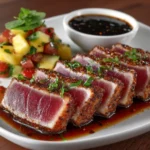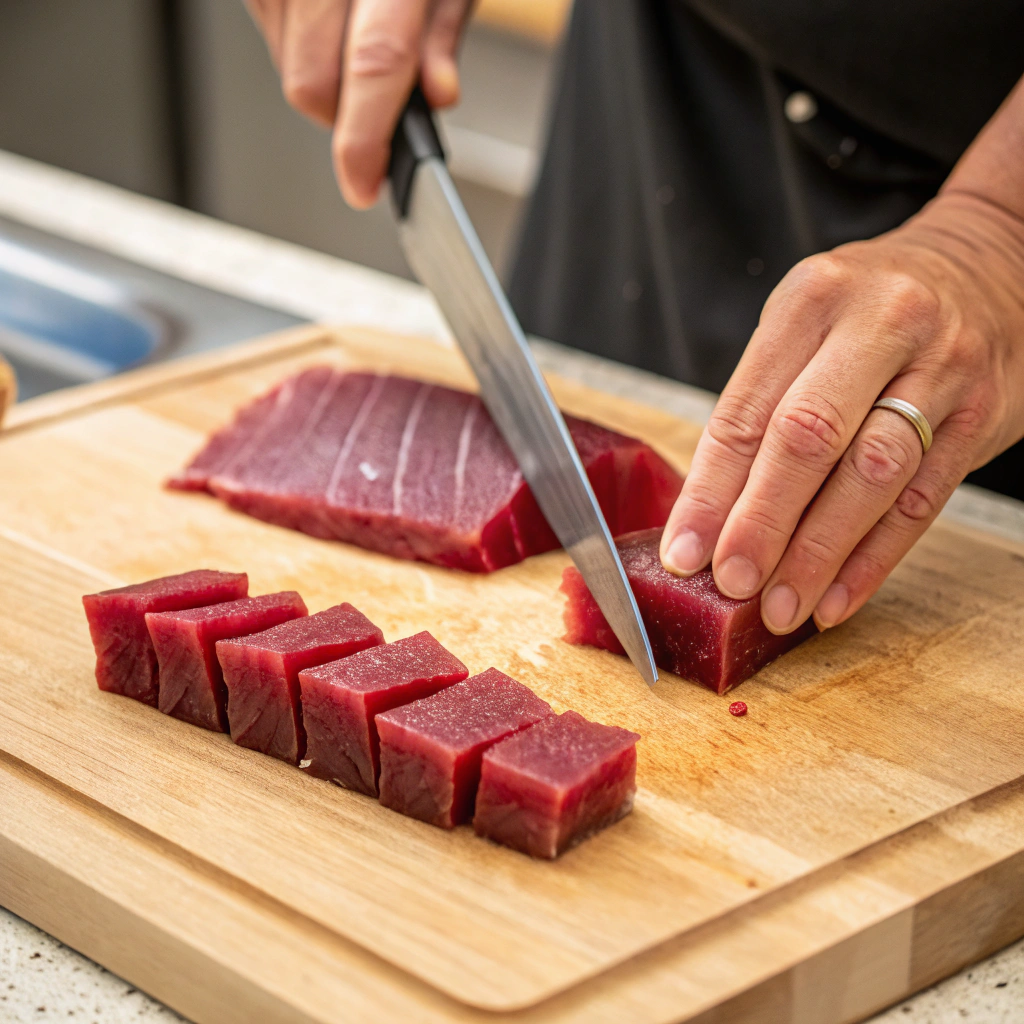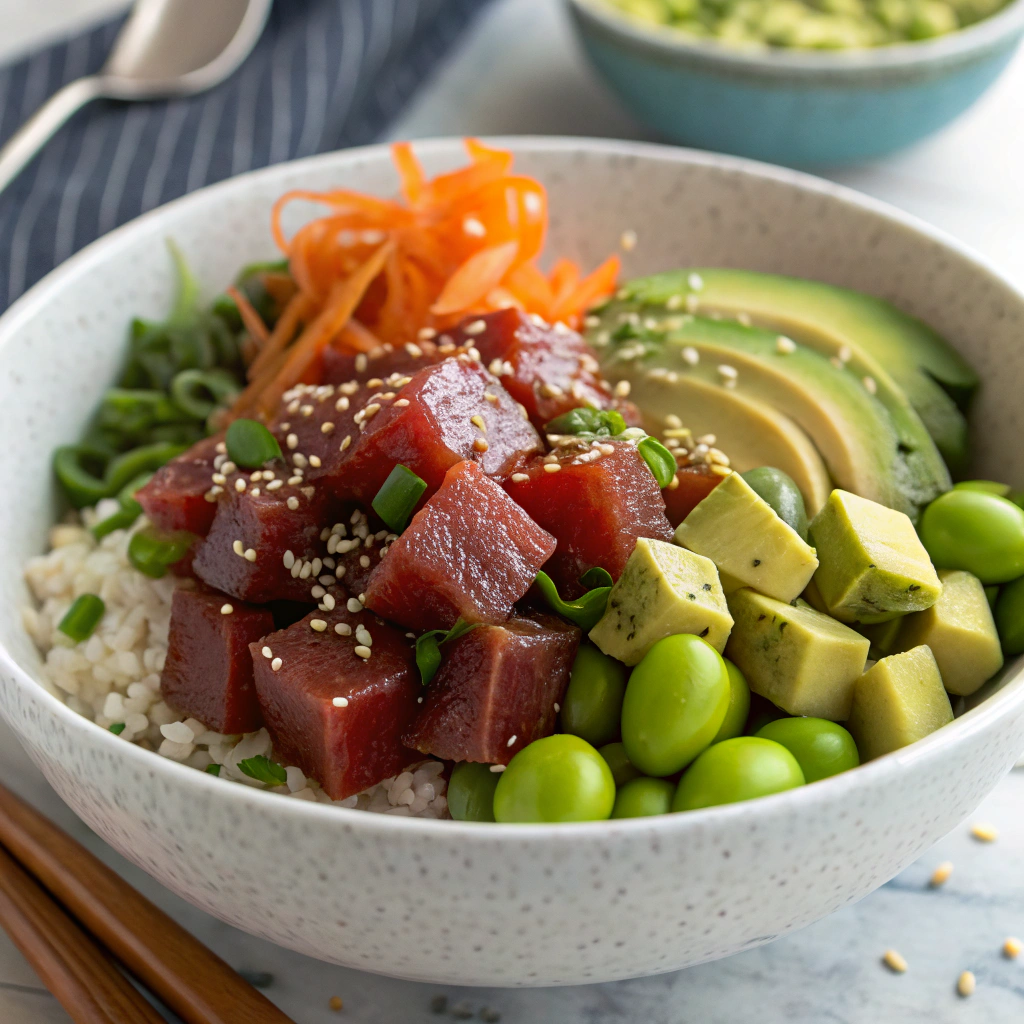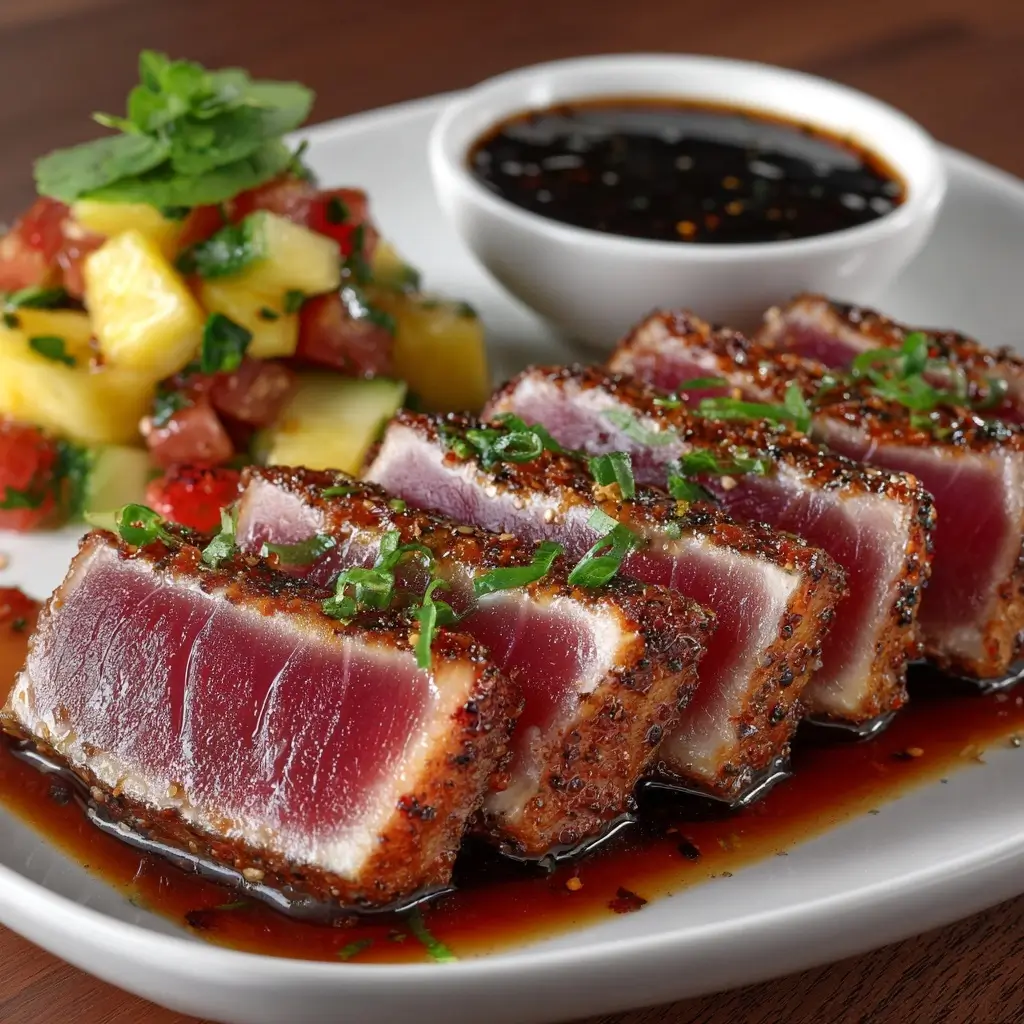While seared ahi tuna gets all the attention, the most flavorful and versatile ahi tuna recipes actually skip the searing step entirely. Most home cooks default to searing ahi tuna, missing out on diverse preparation methods that showcase the fish’s natural flavor and texture. This comprehensive guide will help you master 12 expert-approved no-sear ahi tuna recipes that deliver restaurant-quality results in your own kitchen.
From traditional Hawaiian poke bowls to elegant tartare preparations, these ahi tuna recipe variations celebrate the fish’s pristine quality without masking its natural taste through high-heat cooking. Whether you prefer raw preparations that highlight the tuna’s buttery texture or gentle cooking methods that preserve its delicate flavor , you’ll discover techniques that professional chefs use to create memorable dishes.
Table of Contents

12 Best Ahi Tuna Recipes (No-Sear Methods) – Raw & Cooked
- Total Time: 75 minutes (including marinating time)
- Yield: 2 servings 1x
Description
This Sesame Ginger Ahi Tuna Steak recipe is a quick, healthy, and flavorful dish perfect for weeknight dinners or special occasions. With a simple marinade and a quick sear, you’ll have restaurant-quality tuna steaks ready in minutes. Serve them over rice, salad, or thinly sliced vegetables for a complete meal.
Ingredients
For the Tuna:
- 2 (6 to 8 ounce) ahi tuna steaks (¾ inch thick)
For the Marinade:
- 2 tablespoons toasted sesame oil
- 2 tablespoons soy sauce (or gluten-free tamari)
- 1 tablespoon grated fresh ginger
- 1 clove garlic, minced
- 1 scallion, thinly sliced (reserve a few slices for garnish)
- 1 teaspoon fresh lime juice
Instructions
- Marinate the Tuna: In a bowl, whisk together sesame oil, soy sauce, ginger, garlic, scallion, and lime juice. Place the tuna steaks in a shallow dish or resealable bag, pour the marinade over them, and coat evenly. Cover tightly and refrigerate for at least 1 hour.
- Sear the Tuna: Heat a heavy-bottomed skillet, preferably cast-iron, over medium-high to high heat. Once the pan is hot, remove the tuna steaks from the marinade (shaking off excess) and sear for 1-1½ minutes per side for rare to medium-rare. Cook slightly longer if you prefer less raw tuna.
- Slice and Serve: Remove the tuna from the pan and let it rest for 1-2 minutes. Slice into ¼-inch thick pieces. Garnish with reserved scallion slices.
- Serving Suggestions: Serve plain, with white rice, or over lettuce, thinly sliced cabbage, or fennel. Shown here served over a sliced fennel salad.
Notes
Tips & Tricks for Perfect Ahi Tuna:
- Choosing Tuna: Look for sushi-grade ahi tuna steaks for the best quality and flavor.
- Marinating Time: Don’t marinate longer than 2 hours, as the acid in the marinade can start to ‘cook’ the tuna.
- High Heat Searing: Make sure your pan is very hot before adding the tuna to achieve a nice crust without overcooking the interior.
- Slicing Technique: Use a sharp knife and slice against the grain for the most tender bites.
- Serving Options: Pair with a light salad, steamed veggies, or rice for a balanced meal.
- Prep Time: 10 minutes
- Cook Time: 5 minutes
- Category: Main Dish
- Method: Pan-Searing
- Cuisine: Asian-Inspired
Nutrition
- Serving Size: 1 tuna steak
- Calories: 280
- Sugar: 2g
- Sodium: 800mg
- Fat: 12g
- Saturated Fat: 3g
- Unsaturated Fat: 8g
- Trans Fat: 0g
- Carbohydrates: 5g
- Fiber: 1g
- Protein: 35g
- Cholesterol: 70mg
Essential Guide to Buying and Preparing Ahi Tuna (No Searing Required)
Selecting Sashimi-Grade Ahi Tuna
The foundation of any outstanding ahi tuna recipe begins with selecting the highest quality fish. Sashimi-grade ahi tuna requires specific handling and freezing protocols that make it safe for raw consumption. Look for deep red coloration without brown spots, firm texture that springs back when pressed, and a clean ocean smell without any fishy odors.
When purchasing ahi tuna, seek suppliers who can verify the fish’s handling history. The best sources include Japanese markets, high-end grocery stores with dedicated seafood counters, and online specialty retailers. Ask specifically for “sashimi-grade” or “sushi-grade” designation, and plan to use the fish within 24-48 hours of purchase for optimal freshness and safety.
Food Safety Guidelines for Raw Preparations
Raw ahi tuna preparation requires strict adherence to food safety protocols. The FDA raw seafood safety guidelines provide comprehensive standards for safe handling. Always keep ahi tuna refrigerated at 32-38°F until ready to prepare, use separate cutting boards for fish preparation, and wash hands thoroughly before and after handling.
Cross-contamination prevention is crucial when working with raw ahi tuna. Clean all surfaces with bleach solution, use dedicated utensils, and never allow raw fish to contact other ingredients without proper sanitation between steps. These precautions ensure your ahi tuna recipes remain both delicious and safe.
Essential Tools and Equipment
Proper tools make the difference between amateur and professional results in no-sear ahi tuna preparations. A sharp, high-quality knife with a thin blade allows for clean cuts that preserve the fish’s cellular structure and prevent tearing. A flexible boning knife works well for precise portioning, while a traditional sashimi knife provides the ultimate cutting experience.
Additional equipment includes a dedicated cutting board for seafood, kitchen scale for accurate portioning, and clean towels for maintaining dry work surfaces. Stainless steel mixing bowls prevent flavor absorption, while fine-mesh strainers help achieve restaurant-quality presentations in your final dishes.
12 Best Raw Ahi Tuna Recipes (No Cooking Required)
Classic Hawaiian Ahi Poke Bowl
This authentic Hawaiian ahi tuna recipe celebrates the island tradition of simple, fresh preparations. Cut 1 pound sashimi-grade ahi tuna into ¾-inch cubes, maintaining consistent sizing for even flavor distribution. In a large bowl, combine the cubed tuna with 2 tablespoons soy sauce, 1 tablespoon sesame oil, 1 teaspoon rice vinegar, and ½ teaspoon grated fresh ginger.
Add diced green onions, toasted sesame seeds, and thin-sliced jalapeño for authentic Hawaiian flavoring. Let the mixture marinate for 10-15 minutes to allow flavors to meld. Serve over steamed rice with sliced avocado, pickled vegetables, and additional sesame seeds for garnish. This traditional preparation method preserves the ahi tuna’s natural texture while adding complementary flavors that enhance rather than overpower the fish.

Ahi Tuna Tartare with Avocado
French-inspired tartare showcases ahi tuna’s elegance through precise preparation and refined presentation. Finely dice 8 ounces sashimi-grade ahi tuna using a sharp knife in a cross-hatch pattern, creating uniform pieces roughly ¼-inch in size. This ahi tuna recipe requires attention to knife technique for professional results.
Combine the diced tuna with minced shallots, capers, Dijon mustard, and fresh lemon juice. Season with sea salt and white pepper, then fold in diced avocado just before serving to prevent browning. Present the tartare using ring molds for restaurant-style plating, garnished with microgreens and served with crisp crackers or toasted baguette slices.
Japanese-Style Ahi Sashimi
Traditional sashimi preparation emphasizes the ahi tuna’s pure flavor through minimal intervention. Using a single, confident motion, slice the tuna against the grain into pieces approximately ¼-inch thick and 2 inches long. The key to exceptional sashimi lies in knife technique and fish quality rather than additional seasonings.
Arrange the sashimi on a chilled plate with pickled ginger, wasabi, and soy sauce for dipping. The clean, simple presentation allows the ahi tuna’s natural sweetness and buttery texture to take center stage. This preparation method represents the pinnacle of no-sear ahi tuna techniques.
Ahi Tuna Crudo with Citrus
Italian-inspired crudo brightens ahi tuna with citrus acidity and Mediterranean flavors. Slice 12 ounces ahi tuna into thin pieces using a sharp slicing knife, arranging them in a single layer on chilled serving plates. Drizzle with high-quality extra virgin olive oil, fresh lemon juice, and a pinch of sea salt.
Garnish with thinly sliced fennel, orange segments, and fresh herbs like basil or parsley. The citrus components provide natural acidity that “cooks” the fish surface slightly while preserving the interior’s raw texture. This ahi tuna recipe offers a lighter alternative to traditional preparations while maintaining sophisticated flavors.
Spicy Ahi Tuna Hand Rolls
Hand rolls provide an interactive dining experience while showcasing ahi tuna in a traditional Japanese format. Dice 8 ounces sashimi-grade ahi tuna and combine with sriracha mayo, sesame oil, and rice vinegar for a spicy mixture. The heat level can be adjusted based on personal preference while maintaining the fish’s primary role.
Place the spicy ahi mixture in nori sheets along with cucumber strips, avocado, and seasoned sushi rice. Roll into cone shapes and serve immediately to maintain the nori’s crispness. These hand rolls offer a fun, casual way to enjoy ahi tuna preparation without formal plating requirements.
7 Cooked Ahi Tuna Recipes Without Searing
Ahi Tuna Salad with Asian Dressing
This refreshing salad combines gently cooked ahi tuna with crisp vegetables and bold Asian flavors. Steam 1 pound ahi tuna steaks for 8-10 minutes until just opaque, then cool completely before flaking into bite-sized pieces. The gentle cooking method preserves the fish’s delicate texture while ensuring food safety for those who prefer cooked preparations.
Toss the flaked tuna with mixed greens, sliced cucumber, shredded carrots, and edamame. Dress with a mixture of rice vinegar, soy sauce, sesame oil, and fresh ginger. This cooked ahi tuna preparation offers familiar flavors in a light, nutritious format suitable for lunch or dinner.
Baked Ahi Tuna with Herbs
Oven-baking provides gentle, even heat that cooks ahi tuna thoroughly while maintaining moisture. Preheat the oven to 400°F and season 4 ahi tuna steaks with salt, pepper, and fresh herbs like thyme or rosemary. Place on a parchment-lined baking sheet and bake for 12-15 minutes until the internal temperature reaches 145°F.
The herb coating creates a flavorful crust without the high heat of searing, allowing the tuna’s natural taste to shine through. Serve with roasted vegetables or rice pilaf for a complete meal that showcases this versatile ahi tuna recipe approach.
Ahi Tuna Ceviche
Peruvian-style ceviche “cooks” ahi tuna using citric acid rather than heat, creating a unique texture and bright flavor profile. Dice 1 pound sashimi-grade ahi tuna into small cubes and combine with fresh lime juice, ensuring the acid completely covers the fish. Allow to marinate for 15-20 minutes until the tuna turns opaque.
Add diced red onion, jalapeño, cilantro, and sweet potato for traditional Peruvian elements. The acid from the lime juice firms the tuna’s texture while infusing it with bright, tangy flavors. This preparation method creates a cooked texture without applying heat, representing an innovative approach to ahi tuna preparation.
Steamed Ahi with Ginger
Asian-inspired steaming preserves ahi tuna’s delicate flavor while infusing it with aromatic ginger and scallions. Place tuna steaks in a steamer basket over simmering water, topped with thin ginger slices and scallion pieces. Steam for 10-12 minutes until the fish flakes easily but remains moist.
The gentle steam cooking method prevents the tuna from drying out while allowing the ginger’s warmth to penetrate the fish. Serve with steamed jasmine rice and soy sauce for dipping. This healthy cooking technique represents one of the most nutritious ahi tuna recipes for those seeking lighter preparation methods.
Ahi Tuna Soup
A light, brothy soup showcases ahi tuna in a comforting format perfect for cooler weather. Create a clear broth using vegetable stock, ginger, garlic, and soy sauce, bringing it to a gentle simmer. Add bite-sized pieces of ahi tuna during the final 3-4 minutes of cooking to prevent overcooking.
Include vegetables like bok choy, mushrooms, and green onions for additional nutrition and flavor complexity. The brief cooking time ensures the tuna remains tender while the aromatic broth provides warming comfort. This soup demonstrates how cooked ahi tuna can shine in liquid preparations without losing its essential character.
Expert Tips for Perfect No-Sear Ahi Tuna Preparation
Knife Techniques and Cutting Methods
Proper knife technique forms the foundation of successful ahi tuna recipe execution. Always use a sharp, clean blade and cut with confident, single motions to prevent tearing the fish’s delicate muscle fibers. For cubing, make initial cuts perpendicular to the grain, then rotate the fish 90 degrees for cross-cuts that create uniform pieces.
When slicing for sashimi or crudo, maintain consistent thickness by using a gentle sawing motion rather than pressing down forcefully. The university food safety research emphasizes that clean cutting surfaces and sanitized tools are essential for safe raw fish preparation.
Marinating and Seasoning Guidelines
Successful marination enhances ahi tuna without overwhelming its natural flavors. Acid-based marinades should be limited to 15-30 minutes maximum to prevent the fish from becoming mushy. Oil-based marinades can be applied for longer periods, up to 2 hours, as they penetrate more slowly and provide moisture rather than structural changes.
Salt-based seasonings should be applied just before serving to prevent drawing out moisture that can compromise texture. This timing consideration applies to all no-sear ahi tuna preparations where maintaining the fish’s natural moisture content is crucial for optimal results.
Storage and Food Safety Best Practices
Proper storage extends ahi tuna’s usability while maintaining safety standards for raw preparations. Store sashimi-grade tuna in the coldest part of your refrigerator, ideally on ice, and use within 24 hours of purchase. Never store cut ahi tuna for more than a few hours, as the increased surface area accelerates bacterial growth.
For ahi tuna preparation planning, purchase fish on the day you intend to serve it, or freeze it immediately upon purchase if that’s not possible. Thaw frozen ahi tuna gradually in the refrigerator rather than at room temperature to maintain both safety and quality standards throughout the process.
Nutritional Benefits and Serving Suggestions
Health Benefits of Ahi Tuna
Ahi tuna provides exceptional nutritional value, making these ahi tuna recipes both delicious and healthful choices. According to Harvard nutritional analysis of tuna, this fish contains high-quality protein, omega-3 fatty acids, and essential vitamins including B12 and niacin. These nutrients support cardiovascular health, brain function, and overall wellness.
The omega-3 fatty acids in ahi tuna contribute to gut health benefits while supporting anti-inflammatory processes throughout the body. Raw preparations preserve these nutrients most effectively, as cooking can reduce some vitamin content and alter the beneficial fatty acid profile.
Portion Sizes and Nutritional Information
A typical serving of ahi tuna ranges from 4-6 ounces, providing approximately 150-200 calories and 30-35 grams of high-quality protein. This portion size delivers substantial nutrition while remaining appropriate for various dietary goals and meal planning strategies.
For those tracking nutritional intake, ahi tuna’s high protein content and minimal carbohydrates make it suitable for various eating patterns. The fish’s natural fat content provides satiety while supporting nutrient absorption, particularly for fat-soluble vitamins present in accompanying vegetables and garnishes.
Non-Alcoholic Beverage Pairings
Thoughtful beverage selection enhances the dining experience when serving ahi tuna recipes. Green tea provides a traditional pairing that cleanses the palate between bites, while sparkling water with citrus offers refreshing contrast to rich preparations like tartare or poke bowls.
For those seeking creative non-alcoholic beverage pairings, consider coconut water for tropical preparations, or cucumber-mint infused water for lighter dishes like sashimi and crudo. These beverages complement rather than compete with the ahi tuna’s delicate flavors while providing hydration and additional nutrients.
Frequently Asked Questions
Can you eat ahi tuna raw without searing it first?
Yes, sashimi-grade ahi tuna is specifically processed and handled for safe raw consumption without any cooking required. This high-quality fish undergoes special freezing protocols that eliminate parasites while preserving texture and flavor. The key is purchasing from reputable suppliers who can verify the fish’s sashimi-grade status and following proper handling procedures from purchase to preparation. Many traditional ahi tuna recipes feature raw preparations that showcase the fish’s natural qualities.
What’s the best way to cut ahi tuna for poke bowls?
For perfect poke bowl ahi tuna preparation, cut the fish into uniform ¾-inch cubes using a sharp knife and confident, single motions. Start by slicing the tuna into ¾-inch thick steaks, then cut these steaks into strips of the same width, and finally cross-cut the strips to create even cubes. This consistent sizing ensures uniform flavor distribution and professional presentation. Always cut against the grain to maximize tenderness and maintain the ideal texture that makes poke bowls so appealing.
How long can you marinate ahi tuna without cooking it?
Marinating times for raw ahi tuna recipes depend on the marinade’s acid content. For high-acid marinades containing citrus juice or vinegar, limit marination to 15-30 minutes maximum to prevent the acid from “cooking” the fish and creating a mushy texture. Oil-based marinades with lower acidity can be applied for up to 2 hours safely. Soy sauce-based marinades fall somewhere between these extremes, working best with 30-45 minute marination periods that allow flavor penetration without texture degradation.
What are the best seasonings for raw ahi tuna recipes?
The finest seasonings for no-sear ahi tuna preparations enhance rather than mask the fish’s natural flavor. Traditional options include soy sauce, sesame oil, rice vinegar, fresh ginger, and wasabi for Asian-inspired dishes. Mediterranean approaches utilize high-quality olive oil, lemon juice, sea salt, and fresh herbs like basil or parsley. Avoid heavy spices or overly complex seasoning blends that can overwhelm the tuna’s delicate taste. The goal is creating harmony between the fish and seasonings rather than competing flavors.
How do you know if ahi tuna is fresh enough for raw preparations?
Fresh, sashimi-grade ahi tuna should display deep red coloration without any brown or gray spots, which indicate aging or improper handling. The fish should feel firm and spring back when gently pressed, never feeling soft or mushy. A clean, ocean-like smell is normal, but any strong fishy or ammonia odors indicate spoilage. The surface should appear moist but not slimy, and the flesh should have a bright, translucent quality. When purchasing for ahi tuna recipes, always buy from reputable suppliers who can verify proper handling and storage procedures.
What’s the difference between no-sear and traditional ahi tuna cooking methods?
No-sear ahi tuna preparation methods preserve the fish’s natural texture and flavor through gentle techniques like steaming, baking, or acid-based “cooking” in ceviche. Traditional searing creates a caramelized exterior crust while leaving the interior raw, but this high-heat method can sometimes overpower the tuna’s delicate qualities. No-sear approaches offer more control over the final texture and allow the fish’s natural characteristics to shine through without the intense flavors that develop during searing. Both methods have their place, but no-sear techniques often provide more versatility for different flavor profiles and presentations.

Conclusion
These 12 exceptional ahi tuna recipes prove that skipping the searing step opens up a world of culinary possibilities that often surpass traditional preparation methods. From the clean, pure flavors of Japanese sashimi to the bright acidity of Peruvian ceviche, no-sear techniques allow ahi tuna’s natural qualities to take center stage without interference from high-heat cooking methods.
Whether you choose raw preparations that showcase the fish’s buttery texture or gentle cooking methods that provide comfort and warmth, each recipe in this collection offers a unique way to appreciate this exceptional fish. Remember that success with ahi tuna preparation starts with quality sourcing and proper handling, followed by techniques that respect the ingredient’s inherent excellence.
As you develop your own healthy eating habits, these versatile ahi tuna preparations provide nutritious, satisfying options that support various dietary goals while delivering restaurant-quality results. Start with the preparations that appeal most to your taste preferences, then gradually explore the full range of possibilities that no-sear ahi tuna recipes can offer. The journey from simple poke bowls to elegant tartare represents just the beginning of your culinary adventure with this remarkable fish.

